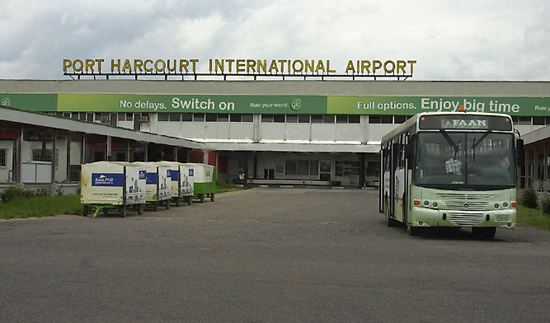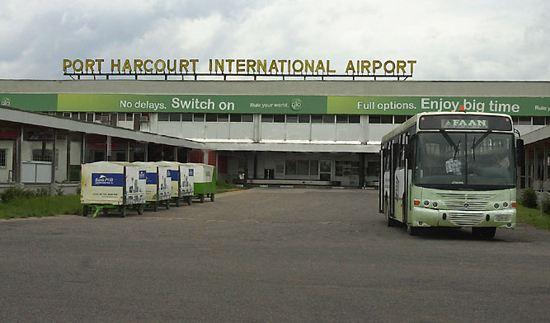
ABUJA, Oct. 31 (Xinhua) -- Pa Thomas Sekibo stood awestruck in front of the brand new international terminal at the Port Harcourt International Airport, a China-assisted project to boost Nigeria's economic prosperity, ready to take a picture of the glittering building.
The 82-year-old retired aviation worker had earlier walked around the building with his grandson who guided him to the commissioning of the international airport terminal by President Muhammadu Buhari, last Thursday.
"This is not only an architectural masterpiece, but it is also a beauty to behold! I am glad this was built in my lifetime. It is a day of joy for me, I will rejoice and be glad in it," Pa Sekibo told Xinhua.
Still wonderstruck, the octogenarian beckoned to his grandson who further led him into the main building where they took more pictures.
Due to his age, Pa Sekibo's voice was weak and his footsteps were slow. His movement inside and outside the building was aided by a walking stick, with his grandson showing him the way to go.
The infectious smile on Pa Sekibo's face reflected a great feeling of joy as he walked past the hi-tech facilities built inside the airport terminal. "As a former aviation worker, I can say this building will pass for the most beautiful airport terminal in Nigeria right now.
"This is not so different from what we see in other parts of the world. I'm looking forward to my next trip abroad, using this facility," he said.
The international airport terminal project was executed by the China Civil Engineering Construction Corporation (CCECC) which is involved in many ongoing infrastructural projects, including rail and road construction in Nigeria.
Construction of the new 600-million-U.S. dollar airport terminal in Port Harcourt, the country's oil hub and capital of the southern state of Rivers, is expected to open more convenient air routes as well as contribute immensely to the economic and infrastructure development of Nigeria.
The project was done in partnership with the Chinese government, involving a loan of 500 million U.S. dollars from the Export-Import Bank of China and 100 million dollars in counterpart funding from the Nigerian government.
The facility is one of four new international airport terminals built in the country's major airports to modernize operation and passenger facilitation. It is to enable the Nigerian government to realize its set objective to elevate the aviation industry to meet international standards and for the sector to be one of the first 20 by 2020.
Travelers and users of the major airports in Nigeria have always complained about congestion, insufficient facilities, and outdated equipment, describing the airports as a disgrace for a country desirous of promoting tourism.
The structure of the new two-story terminal building includes the apron, a cargo terminal building, external works, and other ancillary works.
Speaking at the well-attended commissioning of the new terminal on Oct. 25, Buhari described the world-class facility as "a significant landmark" for international travelers in the most populous country in Africa.
He also said the construction of the international terminal came at the right time for Nigeria, as the Federal Government responded to a global trend in which aviation became a catalyst for economic growth as a result of massive and speedy movement of persons, goods, and services in a safe and secure manner.
Many other Nigerians have hailed the project as one that will boost the economy of Nigeria, considering the strategic status of Port Harcourt city as the country's oil hub and home to thousands of expatriates and oil multinationals.
The Port Harcourt International Airport is the third-busiest airport in Nigeria.
"This new international airport terminal will bring about prosperity in our economy. It will strengthen foreign trade, cultural exchanges with foreign countries and the development of tourism. I think it will also strengthen the links between Port Harcourt and other states within Nigeria, as well as external links abroad," said Funmilola Oloyede, an international businesswoman.
Oloyede said from her own point of view as a businesswoman, the airport terminal will help in accelerating the process of economic and social development through the development of civil air transport.
Michael Jiang, a managing director of CCECC in Nigeria, told Xinhua the new airport terminal would help Nigeria achieve the major objective of connecting people through air routes, land, sea routes and promoting economic prosperity.
On August 18, 2006, the old international airport terminal in Port Harcourt was closed for repairs. Nigeria's aviation authorities said the emergency shutdown was in order to overhaul the runway and build a fence around the facility.
In December 2007, the airport was reopened to a limited capacity but operations were restricted to daytime until the first quarter of 2008.
On Dec. 3, 2012, the contract for the construction of the new international airport terminal was signed, but large-scale construction commenced on March 1, 2014.
Nigeria's Minister of Aviation Hadi Sirika said that with the new facility set for use, Nigeria has achieved a milestone in the implementation of its aviation roadmap.
The old international airport terminal had the capacity to handle 1,081,587 passengers annually, but Sirika said this new airport terminal has the capacity to handle seven million passengers yearly.




 A single purchase
A single purchase









